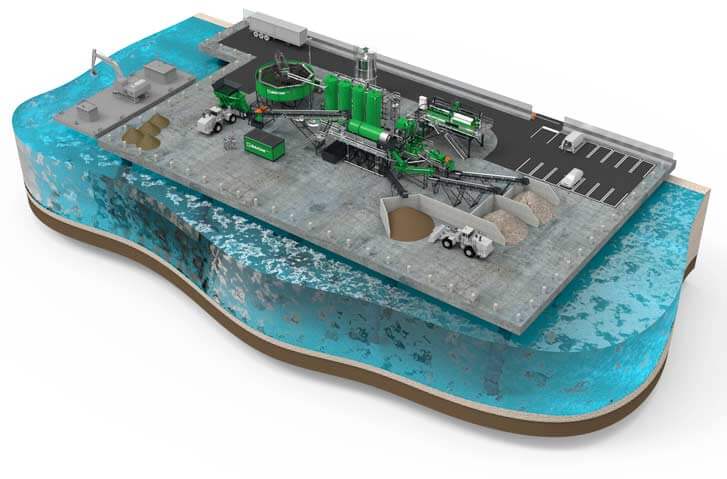Sediment washing: how to treat contaminated sediments
Sustainable treatment of dredged sediments
Sediment washing: in recent times dredging operations of port and/or river sediments have increased, in the past they were carried out to keep the correct operational functionality of the ports, today the need for interventions with environmental rehabilitation operations aimed at ensuring the maintenance of adequate quality standards of the marine environment. Therefore, bearing in mind a economic and structural necessity, the port manager who needs to think about a dredging activity today, cannot ignore the restrictions deriving from the protection of the coastal strip, the marine environment and public health.
Now we wonder how dredged materials can be treated!
The destination of the same is determined based on contaminants herein contained, on the quantity and nature of pollutants. Polluted dredged sludge cannot in any way, in the light of current regulations, be reintroduced into the sea, but must be handled, treated, recovered or disposed of.
Is there a technology applied for the decontamination of this sludge?
Yes, because escavated material is considered as waste with Italian CER code marking. Therefore there is a need to take vigorous action towards it!
The technique studied and developed by Baioni, called ‘sediment washing‘, aims at overcoming the pollutant matrix, mainly because sediments have peculiar characteristics that can ease the reduction of the toxicity of the pollutant absorbed. It is important to highlight some characteristics that make dredging sediments very different from reclaimed soils and that can be studied to determine and develop specific treatments aimed at recovery.
In marine sediments, compared to generic contaminated soils, it is possible to find:
– higher humidity values.
– a clear prevalence of the finer particle size fractions.
– high salt content.
– greater heterogeneity of contaminants.
– simultaneous presence of both organic and inorganic contaminants.
Now, considering these characteristics, Baioni offers a valuable contribution to the protection of the marine / fluvial environment, through the design, production and commissioning of sediment washing plants for sediment remediation, in which the washing processes of soil and sediments precisely ‘washing ‘, are based on the chemical and mechanical extraction action that a liquid carries out against the contaminated solid matrix. This liquid is generally water, possibly with the addition of chemicals and / or surfactants suitable to make the contaminants more similar to the liquid phase rather than to the solid phase.

Generally, installations designed for washing contaminated soils and sediments can also carry out a granulometric separation of the solid part, breaking it down into its various fractions; in this way it is possible to carry out a more targeted decontamination, as the coarser fractions will be easier to clean up than the finer granulometry fractions.
Unlike normally contaminated soils, marine sediments have a high concentration of chloride ions, as a consequence of their stay in seawater. This quantity is very often of such a magnitude as to be not only harmful, but also incompatible with the concentration limits forced for the recovery and / or disposal of sediments. However, contamination by chloride ions can be conveniently cancelled – or in any case drastically reduced – by washing operations designed ad hoc on the basis of the nature of the sediments and their initial concentration.
The type of extracting agents used in washing treatments varies according to the nature of the contamination as well as the ways in which the various contaminants are bound to the solid material. It is also important to highlight that a sediment washing treatment would allow not only the reduction of the concentration of organic and inorganic contaminants, but also the reduction of wastewater to be disposed of, which before being disposed of can be conveyed to a special dedicated plant, where they can be subjected to a wastewater treatment plant and subsequently reused or disposed in compliance with the law.
The goal of Baioni sediment washing plants and processes is the recovery of material and the consequent reduction of waste to be disposed of. Given that, if correctly applied, this technology always reduces the quantity of waste to be sent for disposal / recovery in other plants, it can be considered environmentally sustainable and consistent with the waste management hierarchy.
Baioni commissioned installations in recent years aims at recovering materials, the recovered sand is subjected to a compliance control process and leaves the site with CE certification as a recycled aggregate, therefore meeting the technical requirements for specific purposes and standards.
